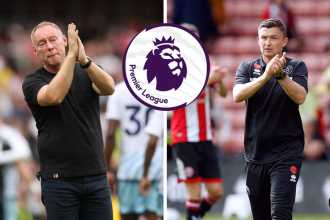Chase grew up in the U.S., but spent much of his life in Japan, making him eligible to play internationally for either country
It's generally easy to spot Anrie Chase on the field. The hair helps, of course. There's a lot of it, but that's not what really stands out. When watching Chase, the first thing you notice is the pure combination of speed and size. Chase is huge, but he moves like he isn't. It's a rare combination for a centerback, and that combination usually leads to a defender reaching a high level.
Just 20 years old, Chase is already playing at that level with Stuttgart, featuring in both the Bundesliga and Champions League. He's gone toe-to-toe with the likes of Kylian Mbappe and Vinicius Jr. on the biggest stage possible, even though this is all just getting started for him.
And that leads to the inevitable question: what's next for him at the international level?
Chase grew up in the U.S., but spent much of his life in Japan, making him eligible to play internationally for either country. He's played exclusively for Japan until this point, but, if you follow the U.S. men's national team, you know how these discussions tend to go. Since breaking through at Stuttgart, Chase has become a major talking point in American soccer circles. Yes, the eagle emojiis and American flags have been out in full force on social media as fans seek to influence the rising defender to play for Mauricio Pochettino's side.
Chase, though, hasn't been totally influenced either way. Despite his experiences with Japan's national team system, he recently revealed that he's open to playing for the U.S. men's national team, although no decision has been made just yet.
"I still feel that playing for a national team is a bit far off for me. Or rather, I can only focus on doing my best for my club at the moment," he told Sportiva. "For now, I’m just letting things happen naturally and seeing where they lead. I’m flattered by all the reports about me potentially playing for the U.S. or in MLS, but that’s not something I’m really thinking about right now."
Why are American and Japanese fans so excited about Chase? And, realistically, what could he contribute internationally in the years to come? GOAL takes a look.
Getty Images SportWhere it all began
It's become a cliche to say a player has risen quickly, but with Chase, it's actually accurate. He's only been playing this sport for a few years, in fact. Born in Japan to a Japanese mother and an American father, Chase moved to Texas at age three, living there until he was 12.
During his time in Texas, Chase gravitated to other American sports, namely basketball. His transition to soccer came later. As Stuttgart boss Sebastian Hoeneß puts it, it was actually "quite late."
Chase didn't adopt soccer as his sport until age 12, but it didn't take long for him to show his ability. By the time he was a teenager, he'd already earned interest from overseas clubs as well as teams in the J-League. Chase decided that he would be more comfortable in a European environment, however, which is how he ended up at Stuttgart.
"The main reason was that in the J-League, I wouldn’t have been able to get playing time right away," he said. "Additionally, I feel that I fall short of some societal expectations in Japan, like speaking respectfully to older players in the traditional manner. I thought that might feel a bit suffocating for me. So, I decided I’d rather be in an environment where I could focus solely on soccer. Since I can speak English, I figured going abroad wouldn’t be a bad idea."
Landing at Stuttgart, Chase became the latest in a long line of Japanese-developed players at the club. He's the seventh Japanese player to make a Bundesliga appearance for the club, following in the footsteps of stars such as Wataru Endu and Shinji Okazaki.
Chase, though, is very much making his own way with the club.
AdvertisementAFPThe big break
Like all players, Chase's rise has been defined by ability. That's usually not all it takes, though, and in Chase's case, it took one coach going above and beyond to advocate for him.
An American-born coach now working at Bayern Munich, Nate Weiss was previously a development coach at Stuttgart. From the beginning, Weiss saw something in Chase. The two bonded over their American heritage and post-training workouts, as Chase looked to play catchup after his late start to the game.
“All the other kids had seven years more experience than he had, but this kid was obsessed with getting better," Weiss told Sky Sports. "There was not a moment when he did not want to train. If I were not around, he would go out by himself.”
And that training also included how to handle pressure.
“In the beginning, the other players would yell at him because he was not good enough," Weiss said. "They would literally be screaming because he was constantly playing bad passes, constantly under pressure. He was not doing well. Eventually, he started catching up… saw the development in front of my eyes. When I look back, I get goosebumps thinking about it.”
Eventually, Hoeneß was convinced of Chase's talents, and he too put his faith in the young defender. After playing for Stuttgart's youth and reserve teams, he made his Bundesliga debut in a 3-1 loss to Freiburg early in the season. He then began to crack the starting lineup and has now made seven Bundesliga starts as part of 11 total league appearances.
He's made four appearances in the Champions League, too, including a start against Atalanta while coming off the bench against the likes of Juventus and Real Madrid.
©Taisei IwamotoPhysical attributes
Especially early in his career with Stuttgart, Chase's game was very much based on his physical gifts. At 6-2, the height and size are easy to see. The speed, too. Those attributes got him to Germany, despite all of the ground he had to make up on the technical side.
Those physical strengths aren't what impressed Weiss, though. More than anything, it was the attitude.
“If you tell a player to run 100 meters as fast as they can, most players understand what that means," he said. "If you ask them to concentrate for the next three-and-a-half minutes during the next possession exercise, they do not really know what it means to give 100 percent. He understood how to concentrate, how to do his recovery, how to do all of it. Very few young players today really understand what that means but he did. I use Anrie as an example when I am coaching. Those are the ones who make it.”
The biggest thing for Chase now is consistency. Despite frequent talk of his lack of technical ability, Chase is in the 87th percentile of centerbacks in pass completion percentage across the five major European leagues. It's not just accuracy but volume, too, as he's in the 64th percentile of passes completed. Despite being just 20, he's at right about the 50th percentile in most defensive categories, which are always a bit skewed when breaking down players on good teams like Stuttgart.
There are still plenty of reasons to believe he can get better, too. Blessed with size and athleticism, he continues to refine his ability with his feet and, more importantly, his mind.
“A lot of players now want to be that centerback who can dribble like Neymar," Weiss says. "They want to be world-class at everything. But if you are a young player who focuses on doing one or two things at a world-class level, you have a chance of making it to the top.
“He is an example for young kids to focus on doing one or two things exceptionally well. Anrie has this ability to defend and to head the ball, to win duels, and he does that at a world-class level. That is his weapon. If he can do the rest clean, then that is enough.”
GettyPlayer comparisons
Gone are the days in which a centerback was merely a big, hulking bruiser. The position is more refined now, more modern. At the core, though, a defender has to defend, and Chase's main job is to continue to use his attributes to keep players away from goal.
His passing can be a huge help, and there are no shortage of centerbacks he can look to as examples of big guys who can pass. There's one in his own league who could be a solid role model: Niklas Sule.
Even bigger than Chase at 6-5, Sule is statistically an elite passer of the ball. When healthy, he's a massive presence on defense, but one that is also incredible on the ball. He completes 94 percent of his passes and attempts about 85 a game. Having someone with that composure is almost as valuable as having someone who can do the dirty work that Sule does.
Sule is a five-time Bundesliga winner, a Champions League winner and a 49-cap German international. That's a hell of a resume, despite never being able to crack the "world-class" category. If Chase can reach that level, whoever has him in their team for club or country will have one heck of a defender.
Chase could also look to Manchester City and find some role models in the form of John Stones or Manuel Akanji, both tall centerbacks known for their composure on the ball. Chase, though prefers to look at a different centerback: Liverpool star Virgil van Dijk, widely regarded as the best in the world.
"I watched the J-League and also soccer overseas," he told J Sports. "To raise my soccer IQ, I would closely watch my favorite center backs and learn how they moved. I often watched Liverpool's Van Dijk. He's good at heading, he's not going to lose one-on-one, he can make long passes, everything about him is great. I watch a lot of Premier League games."
Chase is a long way from that level, of course, but there are examples of players who are both physically gifted and technically sound. Chase is still playing catchup on the latter, but he's improving every day, which is why those both with and outside of Stuttgart are so excited.






